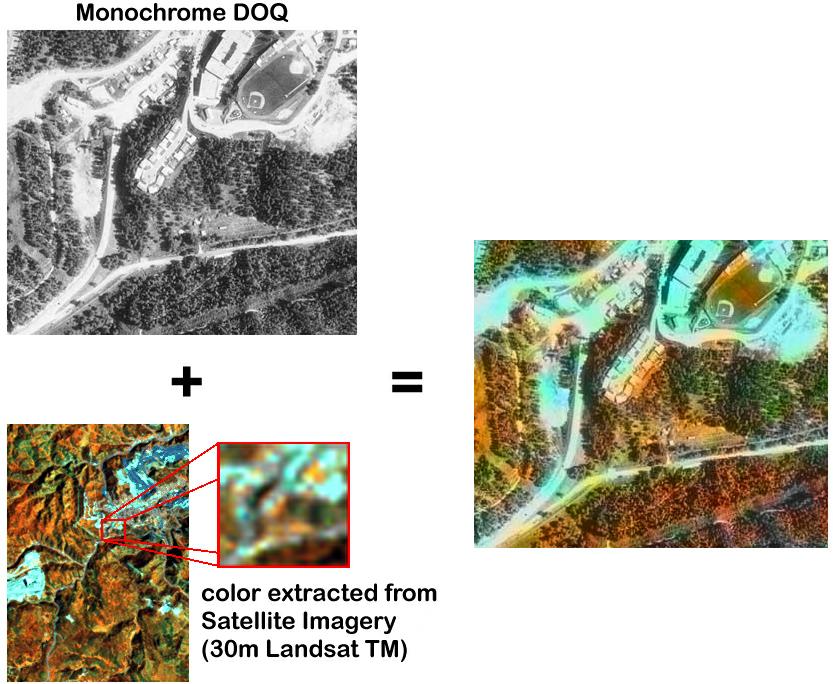
Digital Orthoquadrangle and GeoTIFF
TIFF viewers | GeoTIFF
viewers
| SDTS/GeoTIFF DOQ
| SDTS/GeoTIFF viewers and translators
| What can I do with a DOQ in GeoTIFF?
| DOQ GeoTIFF Example
The USGS now offers Digital Orthoquadrangle (DOQ) in a format called GeoTIFF, a
georeferenced version of the popular Tagged-Image File Format (TIFF).
This allows users with image rendering programs, web browsers, image processing systems,
and geographic information systems to easily read and display DOQ images. If you
have a program that can display TIFF, you can read DOQ. While the DOQ is encoded as
a TIFF image, there is more that you need to know about the USGS product.
First we should describe GeoTIFF. If you
have a program that understands GeoTIFF, the geographic reference of the image will
be read in along with the image. This is an important kind of "metadata"
for people who intend to use the image in conjunction with other geospatial data.
This georeferencing information can be manually input to most programs that need it, but
differences in reference models and input syntax can make this process time consuming and
prone to error.
The Spatial Data Transfer Standard (SDTS) allows a GeoTIFF image
to be included with other files that contain cartographic metadata.
The USGS is working on implementing this for DOQs. If you are fortunate
enough to have software that understands GeoTIFF and also understands
Spatial
Data Transfer Standard (SDTS), you will get the full benefit of this
DOQ product. The SDTS "wrapper" will contain complete metadata for the DOQ,
including all the information that was carried in the original DOQ header and the SDTS data quality report
(e.g. lineage, processing history, accuracy).
We have tested several TIFF viewers that successfully display DOQ images. On the
Windows 95 platform, we tried Netscape, MS Internet Explorer, Adobe Photoshop, Lview Pro,
PaintShop Pro, MS Imager, Image Magick, MS Picture It!, and Wang Imaging. An older
version of MS Imager failed because the DOQ has more than 4096 lines and samples, but
newer versions seem to handle them. On Unix, we tried xv, Netscape, and NCSA
XMosaic--all successful.
We have tested several GeoTIFF viewers that successfully display DOQ images and
correctly ingest the geographic referencing information in the "geo tags." They are USGS's dlgv32, ArcExplorer on Win95, ArcView 3.0 (Unix), and ArcInfo 7.12
(Unix). According to information contained on the GeoTIFF page, there are several other systems with
GeoTIFF ingest capability. They include MapInfo and IDL, and many more are either planned or
functional.
The USGS is currently working on software to build the Spatial Data Transfer Standard (SDTS) "wrapper" or
extension to the GeoTIFF DOQ. The SDTS "wrapper" will contain cartographic metadata
such as data sources, dates, and quality. TIFF is an image format, and cannot easily accommodate these types of cartographic information.
An SDTS/GeoTIFF DOQ transfer will consist of a number of files, most
of which contain cartographic metadata (spatial reference descriptions,
data sources, data quality) and one which contains the image. The image
is the TIFF file, which includes georeferencing information conforming to GeoTIFF. The TIFF file does not
require any preprocessing before you can read it with a TIFF viewer. This permits
a non-SDTS application to still get to the image.
It is important to note that the SDTS/GeoTIFF DOQ is not a separate or new
distribution format, but rather it is the culmination of a single format being
released in two phases. The DOQ in GeoTIFF (no SDTS) is being released
immediately (Phase I) to give customers quick access to our DOQs. Shortly,
we will enhance the GeoTIFF package by adding the SDTS wrapper (Phase II).
Release of the GeoTIFF/SDTS DOQ is forthcoming.
Watch this site for information on SDTS translators.
The USGS is developing programs that can be used as examples for reading SDTS metadata content.
Because you can directly read a DOQ into many programs that read TIFF images, you can
use image rendering software to combine images, merge them to form a mosaic, and
superimpose thematic data using the DOQ for geographic reference. The USGS uses DOQ
images to revise maps, and you can also use your photo interpretation skills to
"heads-up-digitize" features you can see on the image. Because it is
geographically referenced, everything you digitize is similarly registered to a map and to
the earth. Since most DOQ images are panchromatic (black and white), you may even
try to extract color from lower resolution satellite images and then integrate the color
with the spatial detail from the higher resolution DOQ. An example is near the bottom
of this page.

| WebGLIS | SDTS Home Page | MCMC Home | Geography | USGS | Search
sdts@usgs.gov
Privacy Statement || Disclaimer || FOIA
|| Accessibility


